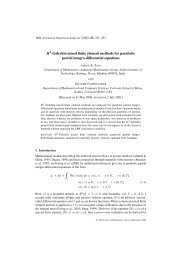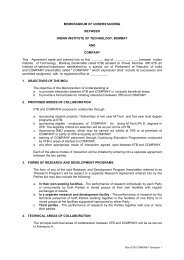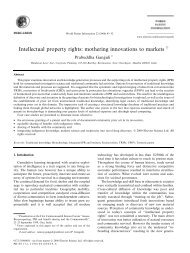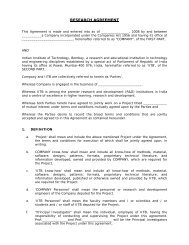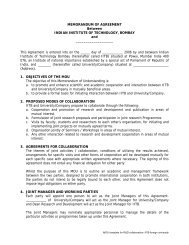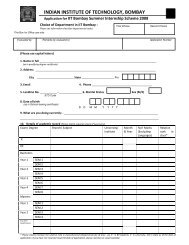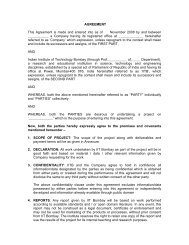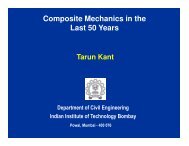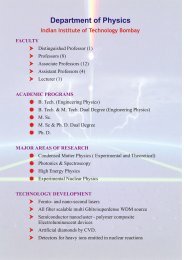Title: Volcanism and earth evolution - IRCC
Title: Volcanism and earth evolution - IRCC
Title: Volcanism and earth evolution - IRCC
Create successful ePaper yourself
Turn your PDF publications into a flip-book with our unique Google optimized e-Paper software.
<strong>Volcanism</strong> <strong>and</strong><br />
Earth Evolution<br />
Hetu Sheth<br />
Dept. of Earth Sciences<br />
IIT Bombay<br />
Barren Isl<strong>and</strong> (India) in eruption, March 2009
• Earth is ~4.5 billion years<br />
old <strong>and</strong> has an average<br />
radius of 6,371 km.<br />
• It has three main divisions<br />
or shells:<br />
1. The core (mostly metallic<br />
iron <strong>and</strong> nickel).<br />
2. The mantle (mostly Fe-Mg<br />
silicate rocks).<br />
3. The crust (various silicates,<br />
carbonates, etc.)
Seven elements that<br />
make up ~97% of the<br />
Earth by mass, <strong>and</strong><br />
which form many<br />
diverse minerals <strong>and</strong><br />
rocks.
Structure <strong>and</strong> fabric of the Earth’s ocean floor, <strong>and</strong> the even more rugged topography of the<br />
continents, as revealed by satellites
Gondwanal<strong>and</strong> <strong>and</strong><br />
continental drift, proposed by<br />
Wegener in 1912
Plate tectonics: Lithosphere is the outer strong shell of the<br />
Earth, consisting of the crust <strong>and</strong> the uppermost mantle, <strong>and</strong><br />
divided into many plates, in perpetual relative motion.<br />
Magma genesis in the Earth is intricately linked to tectonics.
Temperature increases<br />
with depth, but increasing<br />
pressure prevents rocks<br />
from melting. The<br />
geotherm is normally<br />
below the solidus of<br />
mantle peridotite at all<br />
pressures.<br />
The melting temperature of<br />
any substance is directly<br />
proportional to the pressure.
Melting a rock by<br />
decreasing its pressure,<br />
without adding or<br />
removing heat (“adiabatic<br />
decompression”), is very<br />
efficient <strong>and</strong> significant.<br />
Melting a rock by<br />
supplying heat <strong>and</strong><br />
increasing its<br />
temperature is not<br />
efficient or significant.
And, adding a flux (such as H 2 O) to a mineral or a rock at<br />
high pressure greatly reduces its melting temperature.
Two major plate tectonic mechanisms of magma generation:<br />
1. At mid-ocean ridges: Decompression melting of the mantle<br />
2. At isl<strong>and</strong> arcs <strong>and</strong> active continental margins: Reduction of mantle<br />
melting temperature by addition of H 2 O
Continental break-up<br />
between India <strong>and</strong><br />
Madagascar, <strong>and</strong> related<br />
magmatism 88-85 million<br />
years ago, is represented in<br />
southern India.<br />
Coconut Isl<strong>and</strong>,<br />
St. Mary’s Isl<strong>and</strong>s,<br />
Karnataka
India’s subsequent northward drift:<br />
Deccan volcanism during 68-60 Ma<br />
Mahabaleshwar
Mahabaleshwar<br />
Deccan flood volcanism: ~1.5<br />
million km 3 of lava was erupted in<br />
a few million years.<br />
Tyrannosaurus rex<br />
Major environmental crisis – the<br />
K/T Boundary mass extinctions,<br />
including the dinosaurs.
“Flood basalt” volcanism such as<br />
Deccan volcanism is a major<br />
driver of climate change due to<br />
volatiles released.<br />
Broadly speaking, CO 2 produces<br />
atmospheric warming. SO 2<br />
produces atmospheric cooling.<br />
Estimates for CO 2 <strong>and</strong> SO 2<br />
emissions:<br />
For a single 1000 km 3 eruption,<br />
~10 Gt each (= 1 Gt/yr each if<br />
eruption lasted 10 years.<br />
Eruption rate is a key variable.)<br />
Pre-eruptive S contents in<br />
flood basalts (direct<br />
measurements in glass<br />
inclusions): 1000-2500 ppm<br />
Vented as SO 2 , converted to<br />
H 2 SO 4 aerosols, acid rain…
Mumbai city <strong>and</strong> IITB campus<br />
are on rocks of the Deccan<br />
volcanic event.<br />
Basalt, Gilbert Hill, Andheri<br />
Trachyte, Manori Isl<strong>and</strong>, Malad
Still later (about 40 million years before the<br />
present), India collided with Eurasia, raising the<br />
Himalaya <strong>and</strong> the Tibetan Plateau.<br />
Himalayan magmatism involves much remelting of<br />
older crust due to doubling of crustal thickness <strong>and</strong><br />
higher heat flow into the crust.
The substructure of<br />
volcanoes (not to scale):<br />
Visible after millions of years<br />
of uplift <strong>and</strong> erosion of<br />
overlying rocks<br />
Taranga hills, north<br />
Gujarat, are granites<br />
about 800 million<br />
years in age.
Subduction zone magmatism<br />
Mount St. Helens,<br />
USA
1980 Mount St.<br />
Helens ash<br />
cloud during first<br />
13 minutes, <strong>and</strong><br />
map view of the<br />
ash deposit<br />
(thickness in<br />
centimetres).
Left: Artist’s conception of<br />
the A. D. 79 eruption of<br />
Vesuvius that destroyed<br />
the cities of Pompeii <strong>and</strong><br />
Herculaneum
Andaman subduction zone
Barren Isl<strong>and</strong> (~500 m),<br />
India’s only active volcano:<br />
135 km NE of Port Blair<br />
When did it begin?<br />
Narcondam volcano (710 m):<br />
140 km NNE of Barren Isl<strong>and</strong><br />
Extinct? Or simply “sleeping” Examples of huge fissure-type eruptions<br />
(dormant)?<br />
are the famous flood basalt plateaus of<br />
the world, e.g., the Deccan plateau, India.<br />
How old?
Barren Isl<strong>and</strong>’s eruption in March 2009<br />
Barren Isl<strong>and</strong>’s latest eruption<br />
(March 2009)
Barren Isl<strong>and</strong>: Field work <strong>and</strong><br />
sample collection<br />
To be followed by<br />
• Radio-isotopic dating<br />
• Geochemical analyses<br />
• Petrogenetic modelling
Dhule area, Maharashtra<br />
Some benefits of volcanism:<br />
1. Xenoliths (samples of deepseated<br />
rocks)<br />
2. Geothermal energy<br />
3. Economic minerals…<br />
Taiwan<br />
South Africa
ACKNOWLEDGEMENTS<br />
• IIT Bombay<br />
• Department of Science <strong>and</strong> Technology<br />
• Indian Coast Guard<br />
• Photo <strong>and</strong> figure credits: H. C. Sheth, some from Drs. B. Skinner <strong>and</strong> J. Winter, <strong>and</strong> U.S.G.S.<br />
Sunset, Diglipur (North Andaman)



